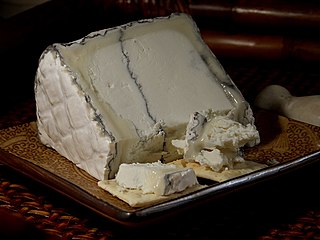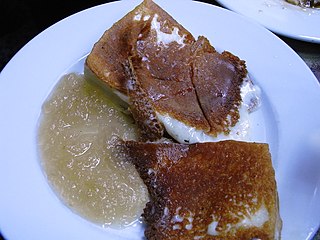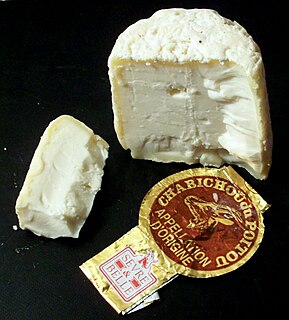
Gruyère is a hard yellow Swiss cheese that originated in the cantons of Fribourg, Vaud, Neuchâtel, Jura, and Berne in Switzerland. It is named after the town of Gruyères. In 2001, Gruyère gained the appellation d'origine contrôlée.

Goat cheese, goats' cheese, or chèvre, is cheese made from goat's milk. Goat cheeses are made in a wide variety of styles, from soft fresh cheese to hard aged cheese.

Wine and food matching is the process of pairing food dishes with wine to enhance the dining experience. In many cultures, wine has had a long history of being a staple at the dinner table and in some ways both the winemaking and culinary traditions of a region will have evolved together over the years. Rather than following a set of rules, local cuisines were paired simply with local wines. The modern "art" of food pairings is a relatively recent phenomenon, fostering an industry of books and media with guidelines for pairings of particular foods and wine. In the restaurant industry, sommeliers are often present to make food pairing recommendations for the guest. The main concept behind pairings is that certain elements in both food and wine interact with each other, and thus finding the right combination of these elements will make the entire dining experience more enjoyable. However, taste and enjoyment are very subjective and what may be a "textbook perfect" pairing for one taster could be less enjoyable to another.

Humboldt Fog is a goat milk cheese made by Cypress Grove, of Arcata, California, in Humboldt County. It is named for the local ocean fog which rolls in from Humboldt Bay.

Fontina is an Italian washed-rind cow's milk cheese. Fontina has PDO status under European law.

Majorero is a goat milk cheese from Spain. Similar to Manchego, this firm cheese has a milky, nutty flavour that goes well with various pear products. It is pale white in colour, and comes in large wheels. Currently it is protected under European Law with Protected Designation of Origin (PDO) status.

Époisses de Bourgogne is a legally demarcated cheese made in the village Époisses and its environs, in the département of Côte-d'Or, about halfway between Dijon and Auxerre, in the former duchy of Burgundy, France, from agricultural processes and resources traditionally found in that region.

Chabichou is a traditional soft, unpasteurized, natural-rind French goat cheese with a firm and creamy texture. Chabichou is aged for 10 to 20 days.

Cheese is a dairy product derived from milk that is produced in a wide range of flavors, textures, and forms by coagulation of the milk protein casein. It comprises proteins and fat from milk, usually the milk of cows, buffalo, goats, or sheep. During production, the milk is usually acidified, and adding the enzymes of rennet causes coagulation. The solids are separated and pressed into final form. Some cheeses have molds on the rind, the outer layer, or throughout. Most cheeses melt at cooking temperature.

Types of cheese are grouped or classified according to criteria such as length of fermentation, texture, methods of production, fat content, animal milk, and country or region of origin. The method most commonly and traditionally used is based on moisture content, which is then further narrowed down by fat content and curing or ripening methods. The criteria may either be used singly or in combination, with no single method being universally used.

Montasio is a mountain cheese made from cow's milk produced in northeastern Italy in the regions of Friuli-Venezia Giulia and Veneto.

Beecher's Handmade Cheese is an artisan cheesemaker and retail shop with locations in the Pike Place Market, Seattle, Washington and New York City's Flatiron District. The company was founded by Kurt Beecher Dammeier in 2003 and opened in the Pike Place Market after Dammeier obtained a difficult to obtain storefront lease in the Market. Because Dammeier had never been a cheesemaker, he sought out the assistance of Brad Sinko, who helped run a family cheese-making business in Oregon. A second location was opened in 2011 in the Flatiron neighborhood of Manhattan in New York City.

Hirtenkäse, or "herder's cheese", is a distinctive cow's milk cheese made in the Allgäu area of Southern Germany.
Clochette is a bell-shaped, mold-ripened goat cheese from the Nouvelle-Aquitaine region in France that is made by Chèvréchard, a goat cheese maker. Clochette is matured for two weeks and has a shelf life of about 45 days. It has a wrinkled, edible white rind; and a firm, dense, velvety texture. The older the clochette, the more wrinkled its surface and the firmer its inner texture. It has a well-balanced, non-challenging, tangy, and goaty flavor.

Cheeses in Mexico have a history that begins with the Spanish conquest, as dairy products were unknown in pre-Columbian Mesoamerica. The Spanish brought dairy animals, such as cattle, sheep, and goats, as well as cheesemaking techniques. Over the colonial period, cheesemaking was modified to suit the mixed European and indigenous tastes of the inhabitants of New Spain, varying by region. This blending and variations have given rise to a number of varieties of Mexican cheeses. These are most popular in the country, although European cheeses are made, as well. Almost all cheese in Mexico is made with cows’ milk, with some made from goats’ milk. More recently, efforts have been made to promote sheep's milk cheeses. Most cheeses are made with raw (unpasteurized) milk. Cheeses are made in the home, on small farms or ranches, and by major dairy product firms. Between 20 and 40 different varieties of cheese are made in Mexico, depending on how one classifies them. Some, such as Oaxaca and panela, are made all over Mexico, but many are regional cheeses known only in certain sections on the country. Some of the least common are in danger of extinction.














